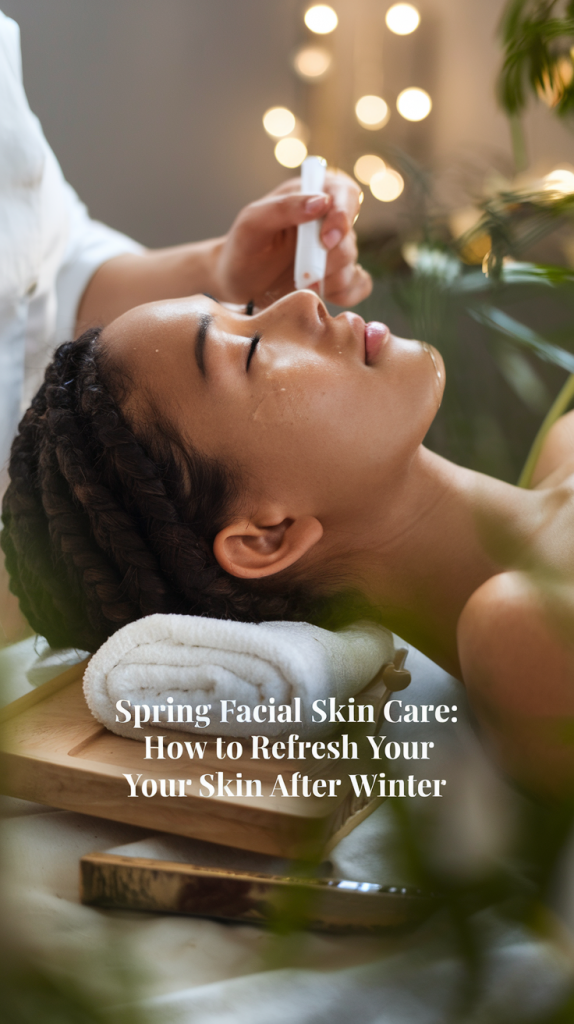Spring Facial Skin Care: How to Refresh Your Skin After Winter
As the chill of winter gives way to the warmth of spring, our skin often shows the effects of months spent battling cold winds, dry indoor heating, and reduced sunlight. This transition season offers the perfect opportunity to refresh your skin, restore its natural glow, and prepare for the challenges of spring. Let me guide you through a comprehensive routine to help your skin recover and thrive.

Why Winter Leaves a Mark on Your Skin
Frigid climate and dry indoor air during winter are the factors responsible for stripping the skin of its natural oils, causing it to become dry, flaky, and even sometimes irritated. The other reason is that more dead skin cells form besides that lack of sunlight which makes your skin appear unglamorous.
Key Winter Skin Issues:
- Lack of humidity and exposure to cold are the causes of dryness.
- Sensitivity: A damaged skin barrier is the reason for the skin becoming more irritated.
- Flatness: Decreased cell division gives a dull look to the skin.
- Breakouts: Oily moisturizers and less cleansing could be the main reason for clogged pores.
By grasping these problems, we can create a spring schedule that specifically tackles them in an effective manner.
How to Refresh Your Skin for Spring
1. Start with Gentle Exfoliation
Shed the accumulation of dead skin cells from winter through exfoliation, which is crucial. However, the skin after winter can be sensitive, so it is better to use mild alternatives to avoid excessive stripping of the skin.
| Exfoliation Type | Ingredients | Frequency |
|---|---|---|
| Chemical | Lactic acid, Mandelic acid | 1-2 times/week |
| Enzymatic | Papaya, Pumpkin extract | 1-2 times/week |
| Physical | Fine, rounded particles | Sparingly, 1 time/week |
- The better way is to refrain from excessive exfoliation, as it is likely to weaken the skin barrier.

2. Hydrate and Moisturize Effectively
After winter, it is essential to rehydrate your skin. Using such products that are both light and hydrating, which make your skin dry deeply without a heavy feeling, is the best option.
- Ingredients to Add:Hyaluronic acid to absorb moisture into the dermisGlycerin and panthenol for real hydrationCeramides for skin barrier repair and reinforcement.
- Layering Suggestion: Start by adding a hydrating serum and then follow it up with a lightweight moisturizer to seal in the moisture.
| Hydration Layer | Key Benefit | Examples |
| Serum | Deep hydration boost | Hyaluronic acid serum |
| Moisturizer | Locks in moisture | Ceramide-based creams |
| Mist | Instant refresh | Aloe vera facial mists |
3. Protect Your Skin with Sunscreen
As the days get longer, so do the hassles and the UV rays of the sun. In such conditions sunscreen is a must that’s no longer up for discussion.
- Characteristics to Consider: Wide-spectrum (UVA and UVB)SPF 30 or moreLighter, non-comedogenic formulas
- This myth is addressed and opened. Yes, wearing sunscreen is also a necessity even when it is cloudy outside or eicht you are inside the house near to the fenestration.
4. Adjust Your Skincare Routine for Spring
When it comes to hot weather, the condition of your skin also changes. You should start using lighter products to avoid clogged pores and the subsequent breakouts but at the same time take care of your hydration.
- The morning routine is to use cleanser followed by hydrating serum, lightweight moisturizer, and sunscreen.
- The regimen for evening is to use a cleanser first, then proceed with a toner that is optional, after that you can treat yourself to a serum (like retinol or vitamin C) and finish it off with a night cream.

5. Incorporate Antioxidants
With the arrival of spring, new environmental stressors are introduced, for instance, increased UV exposure and pollen. Antioxidants are the ones that help neutralize the free radicals and as a result make your skin brighter.
- Vitamin C for brightening and protectionGreen tea extract for anti-inflammationNiacinamide for less redness and better texture
6. Consider Professional Treatments
The use of professional treatments can quicken the process of your skin renewal for a more thorough rejuvenation.
- HydraFacial: Cleanses, exfoliates, and hydrates deeply.
- Chemical Peels: Refurbish the skin and enhance the feel.
- Microdermabrasion: Softly removes the dead skin cells that are on the skin’s surface.
Additional Tips for Holistic Skin Care
Tailoring to Your Skin Type
- Dry Skin: Stick with hydrating and barrier-strengthening products.
- If you have oily skin, you should choose gel-based moisturizers and lightweight serums.
- Informantيلات البشرة الحساسة: استخدم السلع الخالية من العطور و الهايبوالرجين.<|disc_score|>1
- Combination skin: Apply your special oily and dry zone treatment.
Lifestyle and Nutrition
- Hydration: To uphold the moisture levels of the skin, consume a lot of water.
- Dietary practices: Eat foods that contain a high level of antioxidants (like berries and spinach) and omega-3 fatty acids (like salmon and walnuts).
- Sleep: Prioritize 7-8 hours of quality sleep to support skin repair.
Lymphatic Drainage
You can use accessories such as jade rollers or gua sha to ease puffiness and enhance blood circulation. Don’t forget to spend 5 to 10 minutes daily on facial massage as this will help your skin to glow better.

Addressing Common Misconceptions
- “You don’t need moisturizer if you have oily skin.” Moisturizer is essential for all skin types to maintain balance.
- “Sunscreen is just for days when the sun is out.” Daily use of sunscreen is a necessity because UV rays can still come through clouds and windows.
Frequently Asked Questions (FAQs)
1. When is the most appropriate time to exfoliate in spring? You can exfoliate your skin 1-3 times every week but it largely depends on the type of your skin and its degree of sensitivity.
2. What are the must-have components for springtime skin care? Seek for hyaluronic acid, vitamin C, niacinamide, and sunblock that is lightweight.
3. Is it legitimate to use the same products all year round? No, you should switch your seasonal skincare routine that suits your skin accordingly according to each season.
4. What does a basic spring skincare routine look like? Morning-Cleanser → Antioxidant serum → Moisturizer → Sunscreen and Evening-Cleanser → Treatment serum → Night cream.
5. What is the hack for stopping springtime breakouts? Besides switching to noncomedogenic products, it is also important to cleanse properly and not to over-moisturize.
6. Are there any natural treatments for skin care in spring? Certainly, masks with aloe vera, honey, or yogurt are able to moisturize, and comfort the skin in an all-natural way.
Conclusion
Spring is the most suitable season for your skin to get a fresh start, as it changes from thick winter skin to light, hydrating, and protective routines. With gentle exfoliation, deep hydration, and the addition of antioxidants, your skin will recover its initial shine and endurance. Adopting a skincare regime that matches your skin type and promoting holistic approaches will give you a healthy and beautiful look to enjoy the spring with. Ambition to the daily skincare schedule, you’ll be able to get radiant skin that is fully ready for the discover of the season driving your wearisome stack of holism aside.
